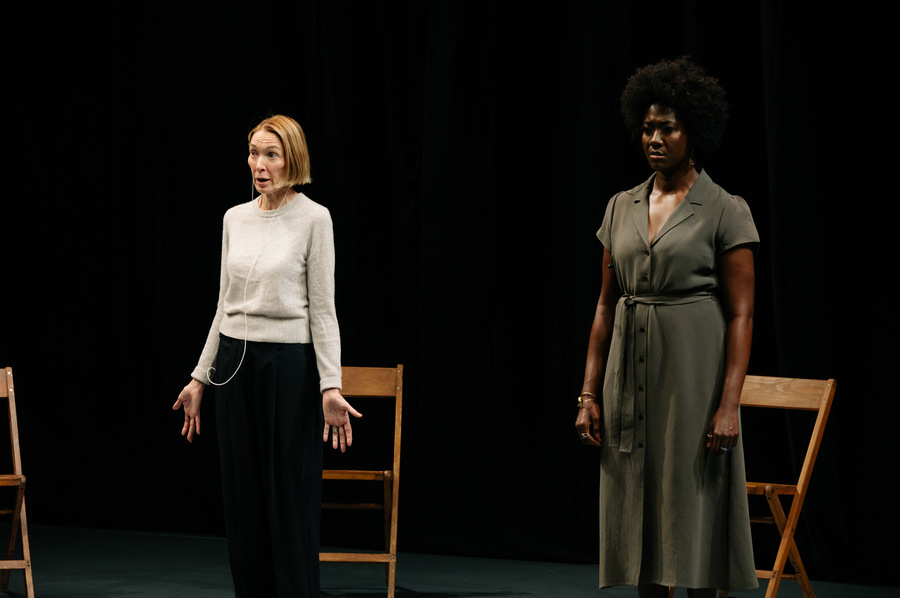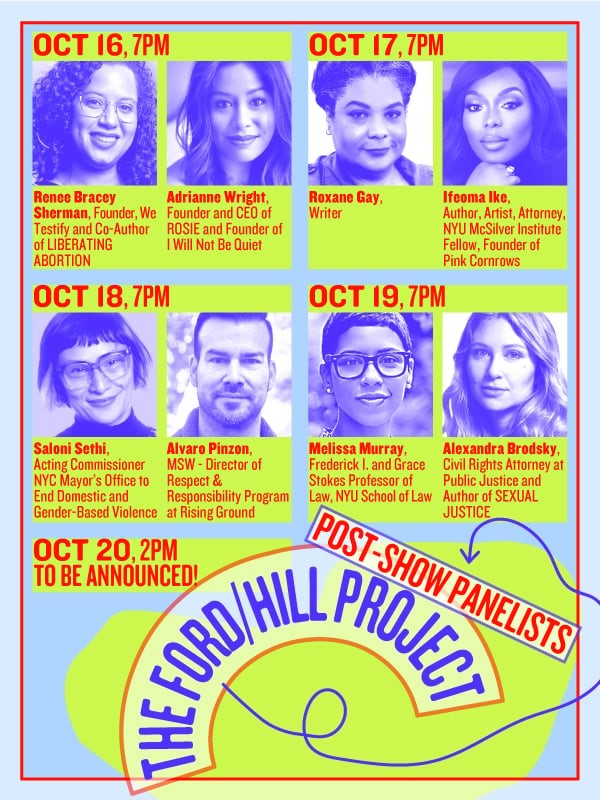ROB WEINERT-KENDT: Tell me about the genesis of this piece.
ELIZABETH MARVEL: During the great pause that we all made it through, I had time to reflect as an artist. You know, time is the one luxury that none of us ever have. And I suddenly was able to sort of self-interrogate, and as always, I had questions like: What is meaningful to me? Something that kept coming up for me was, what does it mean to be an American? What does it mean to be an American woman? What does it mean to be an American artist? How do I participate in my country and my culture?
In thinking about that, I realized that the two events that had the biggest impact on me were the Anita Hill/Clarence Thomas hearings that I watched on C-SPAN when I was younger, and more recently the Christine Blasey Ford/Brett Kavanaugh hearings. Both struck me as an American, as a citizen, as a woman, but also artistically. The elegance and the formality of the court, and these women speaking to power in the way of almost a Greek play, like Antigone—there was a very similar power dynamic at play in both of those hearings.
So I downloaded the transcripts, which are in the public domain, and started reading them, and they blew my mind. They were so fascinating, and so many of the same figures were present 30 years apart: Joe Biden, Pat Leahy, Chuck Grassley, Lindsey Graham.
Also, I did this little exercise while I was reading: I played with taking away the gender of the speaker. And I found that when I did that, more often than not, the more histrionic, what we consider classically female, very emotional language, always was coming from men, and the more scientific, what we would call classically male language, was coming from the women. I found that fascinating.
When we all came back into engagement with each other, I started talking to Lee Sunday Evans about it. She is one of the smartest theatremakers I know, and she loved this idea. She built a script, and we have been working it, myself and three other actors. We’re creating a bench of actors, because it’s a very fleet piece. It’s all in-ear—we wear in-ear monitors, and the actual C-SPAN audio of the hearings is coming into our ears as we speak it. So anyone can kind of jump in and perform the piece. Our hope is that we can plug it in all over the country, take it to schools, take it to community centers, so other actors can move in and out of the piece.
It sounds like this is not simply a verbatim reenactment of the hearings.
No, it’s not gavel-to-gavel; it’s been edited. It’s very hard to explain, much more exciting to experience. It’s like music. We also play with power dynamics, with the women moving into speaking the men, and the men moving into speaking the women. You never know who is speaking until you know. So it also calls the audience into participation in a way I think is very thrilling.
Another exciting thing about it—we’ve been workshopping it at the Mercury Store, and one of our first groups that watched it was a group of very young artists, high school students. They had no idea who Clarence Thomas or Anita Hill, or even Brett Kavanaugh and Christine Blasey Ford were, or very few of them did. But they completely understood what we were talking about. That was very thrilling, and it’s also something that I feel a great responsibility about as a patriot, really—I want to teach our history, and our recent history, and to share it with those who may not be aware of it, because that history is impacting our daily lives.
I want to know a bit more about that in-ear technology. Are you hearing the audio, then saying it out loud a second later, like a UN interpreter or something?
We’re trying to say it along with it, which is very technically difficult. I’ve never done it before. I’ve been a fan of the Wooster Group since I was 18 and first got exposed to them; I just think they’re the greatest artists, but that was their work—I did not want to participate. So when Lee first proposed it, I was really resistant. But I trust her completely, so I ultimately said, “Well, if she feels passionate about this, then it must be something.” So I submitted to it and I started doing it. At first it was horrible. I hated it! But once I put my actor ego aside, though, what happens is, you move into a completely different experience where you literally are channeling. It’s like becoming a medium and this person is moving through you; you can’t even hear your own voice, so you can’t censor yourself. You can’t try to manipulate what you’re doing. You can’t do your actor tricks. You can only, like, play the music. It’s a really amazing experience as a performer that I am finding absolutely fascinating to do.
What I remember most vividly from Christine Blasey Ford’s testimony was her line about how the laughter of Kavanaugh and his friends at her humiliation was “indelible in the hippocampus.” This is obviously material with huge political implications, but it seems like it’s also about memory, about what sticks with you and why.
Right, she literally explains the neural functioning of memory and trauma, how it works scientifically and neurologically. That’s such a beautiful point, and I appreciate you picking up on that, because that is absolutely another layer of what we’re doing.
What have been reactions to the piece so far? As you know, though most people reacted with horror to the testimonies of Ford and Hill, others felt protective or offended on behalf of the accused men—often but not entirely along partisan and gender lines.
It’s very interesting. We did a sort of fundraiser last week and invited some guests to watch some of the piece. E. Jean Carroll was there. The conversation we all had after we presented some of the work was absolutely fascinating. A few younger women were saying, “A part of me can’t relate to it, because I would never allow this kind of behavior.” We really opened that up and got to talk about that, which is something that is really useful cross-generationally to talk about, because we’re all collectively tolerating it—we’re all internalizing misogyny, experiencing it and participating in it every day. So none of us can say, “Well, I wouldn’t,” because it’s happening, and we must uncover that in ourselves and with each other and talk about it.
I’m so ashamed of it, but there’s still a part of me that has an eye-roll reaction when I hear the name Monica Lewinsky, because I was of an age where my internalization of misogyny was still operating, and I believed the lie that a 22-year-old woman somehow had more power than the President of the United States. That’s my own internalized misogyny. We need to unpack that, because where it all leads is the loss of bodily autonomy, which is where American women are today.
What is it about performing this live in the theatre that can’t be achieved by viewing a recording or reading the transcripts?
It’s a good question, because it’s not a verbatim reenactment. Lee has taken the transcripts and built this piece, and it’s under 60 minutes—it’s not a three-hour slog through the full deal. Dr. Ford and Dr. Hill are standing side by side centerstage, and we cut between each of the women’s testimony, where they both had to stand and tell their experience—the most intimate, private things that had happened to them—in front of the entire world, in the most public forum possible. In the theatre space, we can put these women next to each other. They’re not talking to each other, but it flows like a piece of music, where Anita makes one statement and Christine immediately follows. They live in a parallel world.
And throughout the piece, these echoes hit you, where Joe Biden is making a statement that echoes something Clarence Thomas said earlier, or Lindsey Graham is making a statement that Dr. Ford said earlier. There are things that happen because of the nature of presenting it in the theatre, like the ability for us to gender-swap—to put Dr. Ford’s and Dr. Hill’s words into a male body, or to put Clarence Thomas’s words into a female body, which is a fascinating exercise in and of itself. You can’t do that in any other form. And nothing else can give the citizenry, the polis, the same cathartic experience in a room together.
Also, a huge component of this piece is that we have talkbacks after every performance. Honestly, for some people the show can be triggering, and don’t want to send people out without processing that; we want to hold space after the show for people to be able to talk.
I was intrigued to hear that you’ll be doing a performance for Congressional staffers in D.C. But I would imagine that most of your audiences, at least in the show’s initial run, will be pro-choice urban liberals. So who is this piece for? Are you setting out to persuade anyone, or are you—pardon the cliché—preaching to the choir?
Part of it is preaching to the choir to galvanize the choir. Part of the exercise is to educate, to share our own history. That’s the initial impulse. Yes, we did want to make the piece and have showings before the election while everyone’s highly tuned in—not to sway people in any direction, just merely to engage people with their civic duty. That’s also my motivation: just to get people to engage as Americans with their patriotic duty in this democracy. I feel like I am made from the fabric of America. I am an American artist, and I want to speak and participate and do my civic duty. That’s what I feel like me and this group of artists are doing: a civic service.
Are you going to be performing as Dr. Ford in any recognizable way?
All of these voices have their own music, so when you’re channeling them, what you try to do is play the music—they clear their throats, they stutter, they trip over words. We are doing that very loyally. We’re playing their music. But I’m not playing Christine per se. She has such a specific way of speaking, and that is honored. But as far as sort of transforming into the people? No, we are ourselves.
I know you’re doing the 24-Hour Plays on Broadway soon.
Yes, I love that project, and I love everyone involved in that.
And you’re doing a number of film and TV projects…
I’m doing Mr. Spielberg’s new movie, which I’m very excited about , and this wonderful independent movie called Run Amok.
But we’ve missed you onstage. Your last piece was Long Day’s Journey Into Night in 2022.
You know, I’m a theatre addict. I can’t leave it alone for long. I usually go a year or two between plays, at the most. I can’t not get on a stage.
Rob Weinert-Kendt (he/him) is the editor-in-chief of American Theatre.



